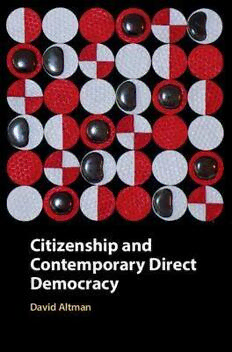
Direct Democracy in Comparative Perspective. Origins, Performance, and Reform PDF
Preview Direct Democracy in Comparative Perspective. Origins, Performance, and Reform
Citizenship and Contemporary Direct Democracy DAVID ALTMAN PontificiaUniversidadCatólicadeChile Citizenship and Contemporary Direct Democracy Standingoutfromallotherbooksondirectdemocracy,Citizenshipand Contemporary Direct Democracy connects the study of direct democ- racy to the broader field of comparative democratization and to an important strand in normative democratic theory. Analyzing the rela- tionshipbetweendirectdemocracyandrepresentativegovernment,this book is organized around three main sections: the origins of contem- porary direct democracy, its functioning, and the ways to improve the useofdirectdemocracyanditsabuse.DavidAltmanarguesthatcitizen- initiated mechanisms of direct democracy constitute an important and viable way to reinvigorate current representative regimes by strengthening democracies’ normative foundations – freedom and equityamongcitizens–whichareparticularlyfragileinthecontextof unequal societies. The book demonstrates how citizen-initiated mech- anismsofdirectdemocracyempowercitizens,channelsocialdemands, defuse violence, re-enchant citizens with politics, and break through some of the institutionalized barriers to accountability that arise in representativesystems. david altman is Professor of Political Science and Chair of Com- parative Politics at the Pontificia Universidad Católica de Chile. His research and teaching interests lie in the field of comparative politics withanemphasisondemocracy.HeistheauthorofDirectDemocracy Worldwide(CambridgeUniversityPress,2011)andhastwicereceived theUruguayanNationalPrizeforPoliticalScience. UniversityPrintingHouse,Cambridgecb28bs,UnitedKingdom OneLibertyPlaza,20thFloor,NewYork,ny10006,USA 477WilliamstownRoad,PortMelbourne,vic3207,Australia 314–321,3rdFloor,Plot3,SplendorForum,JasolaDistrictCentre,NewDelhi–110025,India 79AnsonRoad,#06–04/06,Singapore079906 CambridgeUniversityPressispartoftheUniversityofCambridge. ItfurtherstheUniversity’smissionbydisseminatingknowledgeinthepursuitof education,learning,andresearchatthehighestinternationallevelsofexcellence. www.cambridge.org Informationonthistitle:www.cambridge.org/9781108496636 doi:10.1017/9781108634397 ©DavidAltman2019 Thispublicationisincopyright.Subjecttostatutoryexception andtotheprovisionsofrelevantcollectivelicensingagreements, noreproductionofanypartmaytakeplacewithoutthewritten permissionofCambridgeUniversityPress. Firstpublished2019 PrintedandboundinGreatBritainbyClaysLtd,ElcografS.p.A. AcataloguerecordforthispublicationisavailablefromtheBritishLibrary. LibraryofCongressCataloging-in-PublicationData names:Altman,David,1968–author. title:Citizenshipandcontemporarydirectdemocracy/DavidAltman. description:Cambridge,UnitedKingdom;NewYork,NY:CambridgeUniversity Press,2019.|Includesbibliographicalreferencesandindex. identifiers:lccn2018030912|isbn9781108496636(hardback)| isbn9781108721776(paperback) subjects:lcsh:Directdemocracy.|Politicalparticipation. classification:lccjc423.a51642019|ddc321.8–dc23 LCrecordavailableathttps://lccn.loc.gov/2018030912 isbn978-1-108-49663-6Hardback CambridgeUniversityPresshasnoresponsibilityforthepersistenceoraccuracy ofURLsforexternalorthird-partyinternetwebsitesreferredtointhispublication anddoesnotguaranteethatanycontentonsuchwebsitesis,orwillremain, accurateorappropriate. For my parents, Lea and Ruben, and my sister, Janine, without whom I could have not started this beautiful journey; for my wife, Rossana, for her encouragement and support; and for my kids, Naomi and Matías, who give everything meaning Contents Listof Figures page xi Listof Tables xiii Preface xv Acknowledgments xix Listof Abbreviations xxiii 1 Democratic Innovations for Representative Governments 1 1.1 DemocraticFatigueandOptionsforDemocraticInnovation 2 1.2 DefiningDirectDemocracy 6 1.3 DirectDemocracyandRepresentativeGovernment 11 1.4 OrganizationoftheBook 20 part i origins 2 Breaking Through: The Rebirthof Direct Democracy in the Age of the Nation-State 27 2.1 HistoricalCases 30 2.2 WhatDoWeKnowaboutCI-MDDAdoption? 44 2.3 Conclusions 47 Appendix 49 3 Catching On: Waves of Adoption of Citizen-Initiated Mechanisms of Direct Democracy since World War I 55 3.1 AdoptionofCI-MDDs:ThePuzzle 56 3.2 MeasuringCitizen-InitiatedMechanismsofDirectDemocracy 58 3.3 ReasonsbehindtheAdoptionofCitizen-InitiatedMechanismsof DirectDemocracy 64 vii viii Contents 3.4 EmpiricalEvidence 69 3.5 Conclusions 76 Appendix 78 part ii nature 4 Status Quo Bias? Political Change throughDirectDemocracy 83 4.1 TheEffectsofDemocracyandInstitutionalDesignon PopularVotes 84 4.2 DeterminantsoftheSuccessofMechanismsofDirectDemocracy 86 4.3 EmpiricalEvidence 95 4.4 Discussion 101 Appendix 106 5 Leftor Right? Investigating Potential IdeologicalBiases in Contemporary Direct Democracy 111 5.1 IdeologicalBiasesandDirectDemocracy: PlausibleExplanations 114 5.2 MeasuringIdeologicalDivideandCapitalization 118 5.3 EmpiricalEvidenceandDataAnalysis 126 5.4 Conclusions 137 Appendix 140 part iii reform 6 WhyAdoptDirectDemocracy?MuchMoreThanaSimpleVote 145 6.1 ImpactofCI-MDDsonthePoliticalGame 146 6.2 TheRelationshipbetweenRepresentativeInstitutionsand theCitizenry 149 6.3 DirectDemocracyPerformsBetterThanOtherDemocratic InstitutionalInnovations 156 6.4 Conclusions 165 7 How Can DirectDemocracy Be Improved? Citizens’Commissions andCitizens’ Counterproposals 167 7.1 Representation 167 7.2 DirectDemocracyasaMeanstoControlthePlutocraticTendency ofElections 169 7.3 DirectDemocracyBestPractice 172 7.4 AFurtherTwistonthePromiseofDeliberation 180 7.5 FusingDirectandDeliberativeInstitutions:DeliberativeCitizens’ Commissions(DCC) 183 7.6 ACounterfactualCase:VotingRightsfortheUruguayanDiaspora, October2009 192 7.7 Conclusion 196 Contents ix 8 Conclusions: ANew Democratic Equilibrium 198 8.1 MainFindingsandContributions 198 8.2 ExpandingCitizenshipandtheQualityofDemocracy 204 8.3 TheRoadAhead 209 8.4 FinalRemarks 212 References 213 Index 247 Figures 1.1 Simplified alternatives fordemocratic improvement page 5 1.2 Simplified typology ofmechanisms of direct democracy 8 1.3 Book structure 20 2.1 Genealogy of citizen-initiated mechanisms ofdirect democracy in select countries 43 3.1 Usesof mechanisms ofdirect democracy since 1900 (occurrences percountry–year) 59 3.2 Countries inthe world with CI-MDDpotentialsince 1900 62 3.3 Kaplan–Meier survival estimates forfast democratization 70 3.4 Hazard coefficients predictingthe adoption of CI-MDDs 72 3.5 Venn diagram ofCI-MDD adoption (selected cases, acronyms-year) 73 3.6 Adoption of CI-MDDs by the four main predictors (selected countries) 74 A3.1 Adoption and existence of CI-MDDs atthenational level 80 4.1 Determinantsof success rate (coefficients and confidence interval) 97 4.2 Participation and the probability of success 99 4.3 Quorums and the probability ofsuccess 100 4.4 Governmentdays in office and the probability of success 100 4.5 Growth and the probability of success 101 A4.1 Calculating the status quo surface (SQS) 106 5.1 Examples of SwissPopularParty (SVP) posters 112 5.2 Expected direction ofCI-MDDs 117 5.3 Ideological placementof CI-MDDs instigatorsand governments since 1980 127 5.4 Degree of instigators’extremism by time 130 xi xii List of Figures 5.5 Ideologicalleanings of CI-MDDinstigatorsrelative to government 131 5.6 Gravitational ideological center ofinstigators, controllingfor CI-MDD type 132 5.7 Gravitational ideological center ofinstigators and economic development 133 5.8 Determinantsof MDDs’ acceptance 134 5.9 Determinantsof MDDs’ capitalization 135 5.10 Marginal effects of acceptance and capitalization 136 7.1 Popularinitiative and citizens’ counterproposal 189 7.2 Evolution of Uruguayan public opinion regarding overseas voting 195 Tables 1.1 Eleven voters and eleven questions page 14 A2.1 Mechanisms ofdirect democracy since 1900 (by type and country) 49 3.1 Comparison of countriesat time of CI-MDDadoption versus therest 73 A3.1 Summary statistics 78 A3.2 Cox proportional hazards model estimates predicting the adoption of CI-MDDs 78 4.1 Types of MDDs based on their agenda-setters and policy preferences 87 4.2 Success rates (SR) of MDDs by agenda-setters and policy preferences(1980–2016) 96 4.3 Legislative success rate by bills’origin inseventeen selected democracies 103 A4.1 Typicalquorumsand their status quo surface (SQS) 108 A4.2 Summary statistics 109 A4.3 Binary panellogistic regressions: determinantsof success rate 109 A5.1 Summary statistics 140 A5.2 Logistic and OLS models of acceptanceandcapitalization 141 7.1 CI-MDDdesign considerations 178 xiii
